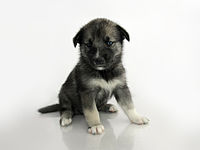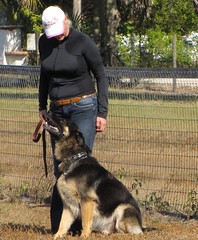 Image via Wikipedia
Image via Wikipedia
To determine the amount of food to begin with when you start feeding a growing puppy, apply the following steps:
Step 1: Find a puppy feeding chart and determine the number of calories per pound of body weight your puppy should have for his age. For example, a 7-week-old pup weighing five pounds needs 400 calories every day.
Step 2: Divide the number of calories contained in a pound of the food you are feeding into the number of calories your puppy needs every day to find out how much food you should offer to begin with. For instance, if the 7-week-old pup is being fed a food containing 600 calories per pound, he needs about 400/600 cal per Ib. or.66 pounds of food each day.
Step 3: Divide the amount of food needed each day into the appropriate number of daily feedings, according to the following rule: If the puppy is from six weeks to four months of age, feed him four times per day. If the pup is from four months to 12 months, feed it three times daily. When the pup is over 12 months, feed him twice daily for the rest of his life, 1/3 in the morning and 2/3 in the evening.
Puppies do not need to be fed six to eight times daily. Although such frequent feedings may improve slightly the efficiency with which the puppy uses the food, it is to such a small degree that the extra time spent in preparing and feeding so many meals is not worth the effort. Puppies have been raised successfully with only two or three daily feedings immediately from weaning, but four seems to be the number that provides the best growth for the least effort by the dog owner. If a puppy cleans up every bit of food offered for three days in a row, add five% more food to the daily feeding. If he continues to eat everything he is offered for three more days, add five% more food.
Continue to add food at this rate until the puppy leaves a tiny bit at each meal. It is entirely possible in a growing puppy, that you may never reach a point at which he will leave any food, until he is almost grown. There is no need to worry as long as the puppy gains about the same amount of weight each week as he did the week before. Between 10 and 12 months of age, the rate at which a puppy grows starts to slow down. At the same time the dog's food consumption also begins to drop. This is a normal occurrence, brought about by the reduction in the dog's need for extra nutrients and energy required for growth. The reduction is simply an indication that the puppy is reaching maturity.
Some dog owners may mistake this reduction in food consumption as an indication of illness. This fear becomes even more pronounced when the maturing process makes the dog less active, as well. Novice dog owners usually forget that human adolescents go through the same steps on their way to becoming adults. Other dog owners may forget the fact that the maturing process in the dog requires only about 12 months to complete, while in humans it usually takes 20 years!
![Reblog this post [with Zemanta]](http://img.zemanta.com/reblog_e.png?x-id=8a079d39-a2f8-4962-9e76-edd8b7eb492e)

![Reblog this post [with Zemanta]](http://img.zemanta.com/reblog_e.png?x-id=5d1f8a26-6ee3-4566-a08e-299588a094be)
![Reblog this post [with Zemanta]](http://img.zemanta.com/reblog_e.png?x-id=e2353d76-c72b-445c-8438-5b2c0b309ea1)

![Reblog this post [with Zemanta]](http://img.zemanta.com/reblog_e.png?x-id=2aa41700-862c-4901-be92-38692361b3eb)

![Reblog this post [with Zemanta]](http://img.zemanta.com/reblog_e.png?x-id=7c7bde7b-5420-4591-8812-59798fe984ac)

![Reblog this post [with Zemanta]](http://img.zemanta.com/reblog_e.png?x-id=b307ea70-66eb-4e9c-8dca-79f240e93442)

![Reblog this post [with Zemanta]](http://img.zemanta.com/reblog_e.png?x-id=b64a7baa-dd22-4706-a9d3-e88f8f0e9621)

![Reblog this post [with Zemanta]](http://img.zemanta.com/reblog_e.png?x-id=204487fd-41e5-4a1b-ab0a-23dced7483ba)

![Reblog this post [with Zemanta]](http://img.zemanta.com/reblog_e.png?x-id=c285cb31-7487-4c18-bf98-3b5454dde6ce)
![Reblog this post [with Zemanta]](http://img.zemanta.com/reblog_e.png?x-id=f798ccdb-d781-4b79-be99-d8b3e1f34f8d)

![Reblog this post [with Zemanta]](http://img.zemanta.com/reblog_e.png?x-id=4f78dd74-7678-4457-971a-f110b6164991)

![Reblog this post [with Zemanta]](http://img.zemanta.com/reblog_e.png?x-id=e01f9959-bbc6-44e0-8eb0-42cc062a55ea)

![Reblog this post [with Zemanta]](http://img.zemanta.com/reblog_e.png?x-id=6cac50db-9c89-423f-8fb3-6556eab8d085)

![Reblog this post [with Zemanta]](http://img.zemanta.com/reblog_e.png?x-id=c934c1b5-f24b-4023-9bc7-a214e62a5e24)

![Reblog this post [with Zemanta]](http://img.zemanta.com/reblog_e.png?x-id=7e2ac34f-6a46-496f-ba62-a5d30c4c4999)

![Reblog this post [with Zemanta]](http://img.zemanta.com/reblog_e.png?x-id=e2fb8feb-ae92-475c-8c91-b670836ba9f8)

![Reblog this post [with Zemanta]](http://img.zemanta.com/reblog_e.png?x-id=265f70ca-e08f-4de5-8184-1415e23b3350)

![Reblog this post [with Zemanta]](http://img.zemanta.com/reblog_e.png?x-id=79151820-5f6c-4b3e-a738-84147d3b0348)

![Reblog this post [with Zemanta]](http://img.zemanta.com/reblog_e.png?x-id=f13f73b8-e222-4278-a288-90768b8819b8)

![Reblog this post [with Zemanta]](http://img.zemanta.com/reblog_e.png?x-id=94801dba-4c27-482b-8311-e6409c10a263)

![Reblog this post [with Zemanta]](http://img.zemanta.com/reblog_e.png?x-id=53ea938e-b66f-44c3-b845-b92cfa98b309)

![Reblog this post [with Zemanta]](http://img.zemanta.com/reblog_e.png?x-id=17c20de5-18c6-4457-baed-c33b5606d9b9)

![Reblog this post [with Zemanta]](http://img.zemanta.com/reblog_e.png?x-id=87522476-d150-4fa8-abd8-196426a950ba)

![Reblog this post [with Zemanta]](http://img.zemanta.com/reblog_e.png?x-id=148b01fb-0724-495d-bb92-2035d3056ebc)

![Reblog this post [with Zemanta]](http://img.zemanta.com/reblog_e.png?x-id=d2f65e48-a271-46a6-9d3c-4fc8c15c9ae0)